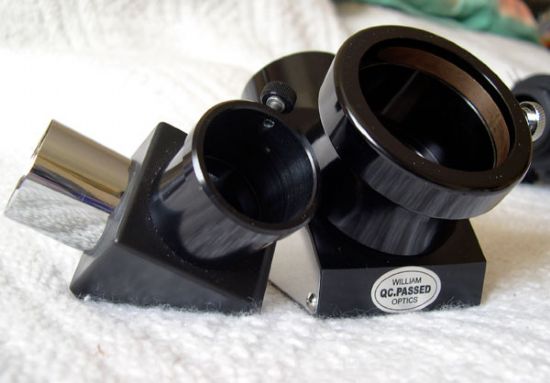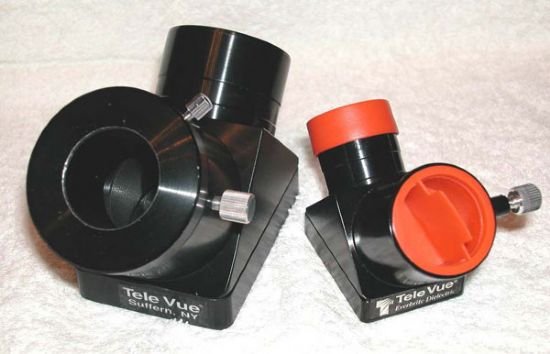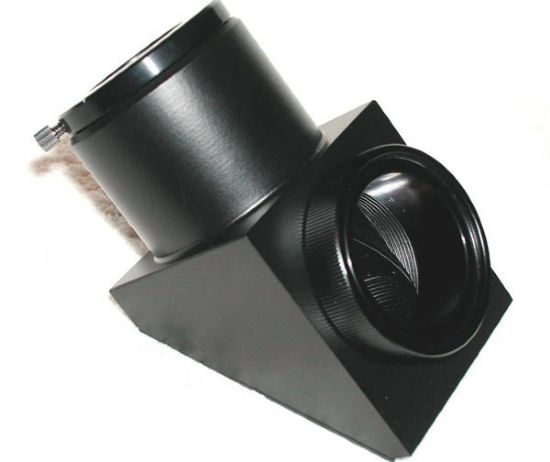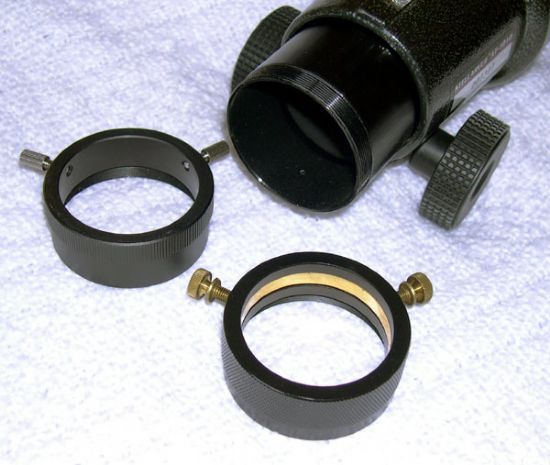The Bit in the Middle
A look at the bits between focuser and eyepiece (part 2)
The Numbers
Having decided whether you want to buy a 2” standard, 2” dielectric, 1.25” with compression ring, amici prism, or whatever type of diagonal, you now have a wonderful choice of products to inspect and choose from. The two companies most famous for producing the finest diagonals have been Televue and Astrophysics, but there are other companies butting into the market. Baader Planetarium and William Optics are two such companies, and they are releasing impressive new types that are competing very well against the traditionally dominant Televue and Astrophysics ranges. If you consider a diagonal will serve a very important job in your telescope, and will be useable with all your eyepieces, you may see it is worthwhile investing in a good one. They can be a bit highly priced, but the best ones really do perform at the best level.

Televue produce a 2” Everbrite dielectric model, the casing for which is machined out of a single block of aluminium. This makes it quite heavy, but collimation will never be an issue. It is 99% reflective and highly rated. UK price is £230. This also comes in 1.25” size (£155), and as a 2” 60 degree version (£175) ideal for nature-watchers and has the same highly reflective surface. The Televue standard 2” ‘Enhanced mirror’ diagonal (95%) costs about £195, but competing against that is the Williams Optics standard 2” diagonal, with 97% reflectivity and a truly beautiful design. This is often quoted as performing at least as well as the Televue units, but costs about half the price at about £95. They also produce a dielectric model for about £200, which is also very highly rated.

Astro Physics’ main model is the 2” Maxbright diagonal. It has all the features of the Televue Everbrite, including 99% reflectivity, brass compression ring, threads for 2” filters etc, and is similar in price. They also supply a 1.25”, 45 degree amici prism diagonal for terrestrial observing which is also highly rated, but probably not best suited for astronomical observing.
Baader Planetarium produces a very adaptable unit called the Precision amici 90 degree star diagonal. It has a 2” body, but can accept either 2” or 1.25” barrels for attachment to either size of focuser. It is 98.5% reflective, and gives a correctly oriented view, so it is quite a piece! I haven’t been able to get a UK price for this, but it would appear to be more expensive than the Televue or Astro Physics units, going by US prices.
 So those are the big boys, with big prices attached,but what if you want to upgrade your diagonal to a better performing one with a slightly lower price tag? Well, there are plenty of options. Antares Optical of New York produce some very cost-effective 2” diagonals that are well made, have high reflectivity and are cheap. Some collimatable models are available too. You may have to order them from overseas, but the US price of $139 (at time of writing = approx. £75) for a quality 2” diagonal that is collimatable and has 1.25” adapter is pretty good value.
So those are the big boys, with big prices attached,but what if you want to upgrade your diagonal to a better performing one with a slightly lower price tag? Well, there are plenty of options. Antares Optical of New York produce some very cost-effective 2” diagonals that are well made, have high reflectivity and are cheap. Some collimatable models are available too. You may have to order them from overseas, but the US price of $139 (at time of writing = approx. £75) for a quality 2” diagonal that is collimatable and has 1.25” adapter is pretty good value.
GSO (Guan Sheng Optics) also produce a very reasonable 2” model, with brass compression ring and 1.25” compression ring adapter, available from their regular eBay distributor from the US for just $59 US (= approx £33 at current exchange rate). This also qualifies as a bargain.
In the 1.25” size there are good quality models available from TAL of Russia (also known as Helios); Orion Optics USA produce a range of very affordable ones including a standard 90 degree mirror with screw fitting for £53 and a hybrid prism diagonal that will allow you to use 1.25” eyepieces in a 0.96” focuser for just £22 - a good way to upgrade the performance of a classic older telescope that only accepts the older 0.96” eyepieces. At the top end of the ‘budget’ range is a great 1.25” diagonal made by Orion Optics UK that boasts a 1/10 wave PV (peak to valley) surface wave accuracy for £95. What does that strange number mean? A surface accuracy figure of 1/10 wave means that a beam of light hitting that mirror will be reflected with an accuracy allowing no deviation greater than 1/10th the wavelength of light, which is a very small amount of variance. The lower the value, the better the performance. For example, 1/20 wave PV is better than 1/10 wave PV, which is better than 1/8 wave PV. Most of the Televue, Williams Optics and other big names boast 1/10 wave PV performance.
Final Reflections
As you can see, the back end of the telescope has a whole load of different accessories available to enhance the view through the eyepiece and ensure that everything is held securely in place. Owners of Schmidt-Cassegrains and Maksutovs should note that quite often there are versions of these diagonals designed specifically to attach to the visual backs supplied with their telescope types. Some attach by means of a thread on the back of the tube assembly, in which case there is no separate visual back as such. One of the pictures shows an Antares model of this type from Andy Ferguson’s collection. There are also additional visual backs for Schmidt-Cassegrains and Maksutovs, available from third-party suppliers, which allow a wider variety of 2” accessories to be used.

Also, Newtonian reflectors should not feel left out in the cold - although there is no need to use a diagonal with a reflector, they still have visual backs attached to the focuser drawtube to hold the eyepieces, etc., and they are not always as sturdy as may be required. Alternative models are available for reflector owners as well, and again they are quite affordable and offer improved security when holding big heavy eyepieces, filter wheels, and other things you do not wish to slip out unexpectedly in the middle of the night.
Many of the items I have mentioned have been reviewed at the usual review sites; Cloudy Nights Reviews, Excelsis, and others. Bear in mind that just like all other equipment required for our hobby, the astronomical hardware retailers sometimes offer them at discounted prices. They do also come up for sale second hand from time to time, so it may be worthwhile keeping an optimistic eye open on your classifieds page of choice.
Happy hunting, and may your eyepieces never drop out.
Click here to go back to page 1
NB - Mercury Systems have ceased production of their excellent products, but they do still appear on the second-hand market!